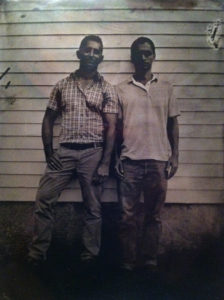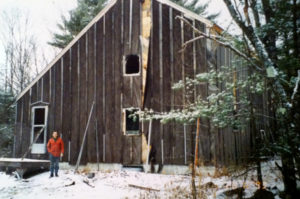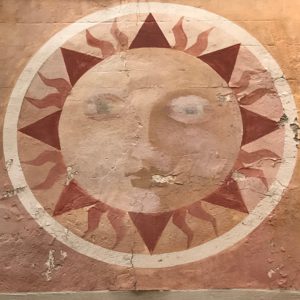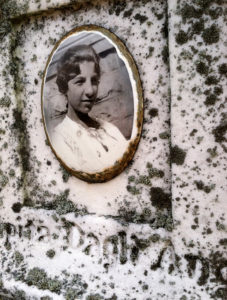
For the first summer in years, Seth and I are doing what folks all over this great land do each summer: we’ve packed up and gone on vacation to escape the heat. We’re in Maine, Seth’s home state, surrounded by pines and maples, average highs in the 70s, lows in the 50s. It’s a bit of a homecoming for both of us. For Seth, this is the land where he grew up. But we’re also staying, for the first time in almost 20 years, in the home where we would spend summers back in the late 1990s. Back then, I was in grad school in Alabama. I’d come to Maine for summer internships, working at times with Brother Arnold Hadd at the Shaker Press at Chosen Land, the Sabbathday Lake Shaker Community in nearby New Gloucester, and at other times with David Wolfe, a printer and book artist on the coast in Portland. No matter where I interned each summer, our home base was The Saltbox, a home that Seth’s dad Cole had begun building from boards that were milled from trees that had been cleared from his land for a new road.
This Saltbox is a replica of an actual Colonial era saltbox in nearby York, Maine, with the distinct shape of this New England style home: two stories in the front, one story in the back, and a pitched roof that slopes down toward the back of the house, making it look like a traditional storage vessel for salt. I have always loved this connexion and its metaphor for home: this most essential act of seasoning food––a pinch of salt––connected to the building in which that act takes place.
When Seth and I were spending summers here, it was pretty rustic. The shell of the building was complete, but the exterior was wrapped in tar paper. There were windows but the interior walls were just beginning to be framed, so we could see each other from clear across the house. Our water came from a hose that Seth ran from outside up to the second floor, the water running into an old elongated cast iron sink, draining out the side of the house through a pipe into the woods below. Our lights were mostly Christmas lights, strung up along the wall studs. Each summer we added more luxuries: a reading lamp, a rice steamer, a toaster oven, an old Philco radio that got louder as the tubes inside warmed up. We heated up water on an electric burner for shaving in a basin with an old mirror that had just a bit of silver reflection left in it. It was hung from a nail in one of the wall studs on the opposite side of our little kitchen table that might fit three people at most, and there were times when we did fit three. We had Brother Arnold over once for dinner. And dinners were usually pretty damn good. We’d make things like fried squash blossoms, harvesting the vegetables from the huge garden Seth planted near his parents’ home, which was a hundred yards away through the woods. We got really good at working within limitations. Each year we took to heart the words summertime and the living is easy. We made it so with what little we had and, to be honest, the living was pretty great.
As we got busier and busier in our post-grad school days, Seth’s father finished up the saltbox project. One year the clapboards and cedar shakes went up. Another year the interior walls were finished with pine paneling and plaster. The place slowly grew up into a real home with modern conveniences like indoor plumbing (no more trudging through the woods late at night to shower). And then last year, his folks decided to rent out their old family home, and move into the smaller, more manageable saltbox.
It’s been six long years since we were last here, and now, visiting Seth’s family for summer vacation, we are back in the saltbox. It has been a wonderful homecoming, back to a place that was in many ways our first home together, and it makes me realize how the passing of time––the great turning, spiraling wheel of the year that is the subject of this very Book of Days––is equally beautiful and sad. I think back to when I was a boy and how summers went on forever, and I think back to when Seth and I were roughing it out here in an unfinished shell of a building and wonder how that could possibly be almost two decades ago. Though much has changed, much is exactly as we left it. The wind still blows through the trees towering around us, the air still is scented with pine, and the saltbox itself still is scented with wood, the wood of the trees that stood once on this land, milled into the boards that are the heart and bones and core of this home away from home.
Image at top: It was Maine Open Farm Day yesterday, and the Shakers opened their farm, the place that provides the culinary herbs and herbal teas that we sell, for the occasion. That’s a tintype of me and Seth that a photographer shot there yesterday; we are standing outside the 1850 Boys’ Shop. And here’s an old photo of the saltbox as it was in 1993, three years before we began using it as our summer home:

The place when we lived here looked not so unlike it did when this photo was taken, though we did have windows. And that’s Seth’s dad Cole in the photo; he looks in this picture not so unlike Seth does now. When it rains, Seth even wears a red coat just like his dad’s. You can view a photo of the saltbox as it is today on the Convivio Bookworks Instagram page. Follow us there @conviviobookworks. We’d be really pleased if you did.
Vacation time has meant time off, too, from writing. My apologies for not writing you about St. Swithin’s Day this past July 15th and Our Lady of Mount Carmel on the 16th. Saturday it was the ancient Roman feast of Neptunalia & Salacia, celebration of the salty sea. Today brings St. James’ Day; oysters are traditional. Tomorrow: St. Anne’s Day––Anne, mother of Mary. St. Martha is celebrated on the 29th and it is Martha who reminds us in her own way that we need not worry so much about appearances. Come Lammas Eve at month’s end, we should be back to Lake Worth and back to our workaday world. Fittingly enough, Lammas brings the traditional beginning of transition from summer to fall.



